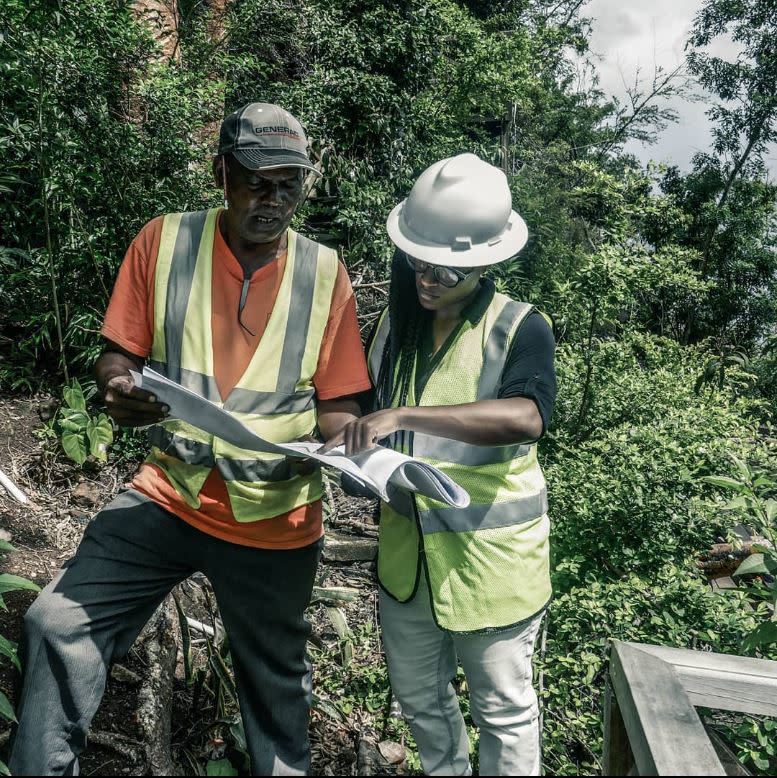This Barbados Native Weathered Storms As A Child — Now, She’s An Architect Replacing Aesthetics With Thoughtful Design

When you think of Black history, you may think of figures of the past who were pioneers in their own right.
However, today, there are individuals amongst us who are carving paths of their own and still creating brighter futures for our people.
One happens to be Barbados native Alyssa-Amor Gibbons, an architectural designer with a mission to preserve and leverage the island’s identity through thoughtful design.
For Gibbons, Barbados has always been a hub of innovation, but she believes it’s not always recognized by the world. Therefore, she plans to fix that by merging engineering with architecture.
“Throughout history, because of our location on the globe, we are the halfway point between the east and the west,” Gibbons told AfroTech in an exclusive interview. “Traditionally, we’ve always been this almost linchpin location where people [and] travelers come to and pass through to get to bigger, better. Not to mention the slave trade and the critical role that Barbados played, where everyone funneled through our small islands onto other countries and continents.”
She added: “I’ve always been obsessed with re-leveraging that identity, but innovatively based on design in a way that shows global solutions can still come from such a tiny place.”
The post This Barbados Native Weathered Storms As A Child — Now, She’s An Architect Replacing Aesthetics With Thoughtful Design appeared first on AfroTech.
Thoughtful Design
Gibbons’ purpose stems from a unique relationship with nature, which she says is shared by everyone on the island.

Here, people do not need to open up their books to learn about climate change because they experience the consequence of the shifts in weather patterns constantly. This centers on the importance of not creating architecture blindly but doing so with sustainability at the forefront.
“Every year you’re basically at the universe’s mercy when it comes to hurricanes, natural disasters, and earthquakes,” Gibbons explained. “So, you feel it and you start to question as a designer, ‘What can I do to make a difference?’ ‘How can I contribute more?’ ‘How can we change the way we do things?’ ‘How do we solve this issue of being so precariously poised on the edge of this whole climate change discussion?’ So, that’s really where my love for not just architecture and design, but sustainability comes from.”
Gibbons’ unwavering approach is still misconstrued by some and she even recalls being faced with the question, “Why do people live in places where you live?” by others.
The question is often presented in areas within the United States, like California, which has reoccurring wildfires and earthquakes.
However, the answer to the question is clear.
“If I vacate my home, where do I go,” Gibbons questioned. “If you look across the globe at the immigration issues that we face as people and then as Black people, where do we go? Who’s gonna accept us? Who’s gonna willingly say, ‘Okay, you face these hurricanes, you face these natural disasters every year, we have land for you. Here, come.'”
She continued: “So, what do we do? We simply do what we can to adapt. We need to think bigger. We need to figure out how do we live within these situations, the experiences, and the issues that we face as communities, as small island developing states.”
Prioritizing Micro Solutions
Adopting flexible thinking has been key to creating designs that allow Gibbons to not work against nature, but with it.

During her TED talk in 2022, Gibbons gave insight into how thoughtful design can be practiced. For example, jalousie windows are commonly used in warmer temperatures and are useful for keeping the sun and rain outside of the home and directing airflow, per Home Reference. The design also allows a person to adjust the window panels, guiding how much sun or air can enter the home.
For Barbados, this minor adjustment in the home can be the difference between a home crumbling or withstanding. Gibbons believes micro solutions, such as jalousie windows, should take precedence over aesthetics.
“It’s not about making stuff look pretty or putting in the new types of spaces that people — who are not forced to live in that space — want to see,” Gibbons said. “It is about analyzing what is needed in this space. People always say the shelter is the first human right, and I think architecture needs to get back to that.”
Dangers Of Prioritizing Aesthetic Over Functionality
In that same breath, Gibbons does believe functionality and tasteful designs can co-exist. However, oftentimes modern designs can often be associated with a smart or high-tech design. The issue with adopting that aesthetic can lead to a barrier within the very community Gibbons is looking to sustain.
“What I’m adamant about as a designer is that, yes, we can build everything ‘super sleek,’ ‘super high tech,’ ‘super modern,’ but what about the farmer on the hillside when a hurricane is coming and they are totally exposed? They don’t have access to a million-dollar budget to retrofit or fix up their home. What do they do,” Gibbons questioned.
She continued: “There’s this elegance that you can achieve by pulling on culture, pulling on vernacular, pulling on the aesthetics and essence of the communities that you’re designing in, but then overlaying and applying emerging technologies and more high-tech tools on top of that. So, there doesn’t need to be this disparity between what the local knowledge of building is and what it takes to be resilient or sustainable or smart.”
Good design and thoughtful consideration will be the basis for any project Gibbons stamps her name on. As of this writing, her focus is on larger housing developments to make a difference in wider communities.
Her marker of success is rooted in the people of Barbados having a place to call home for light years ahead.

